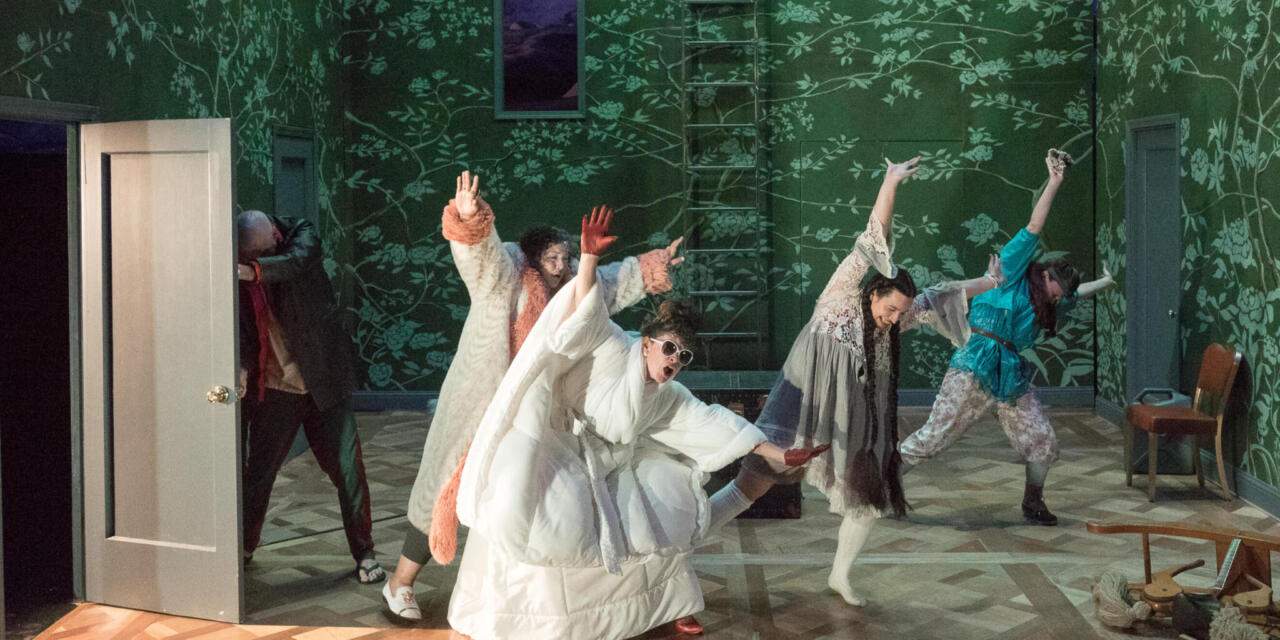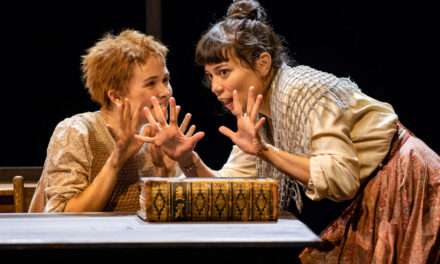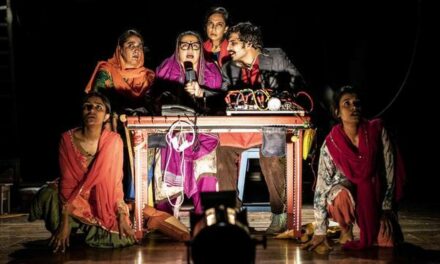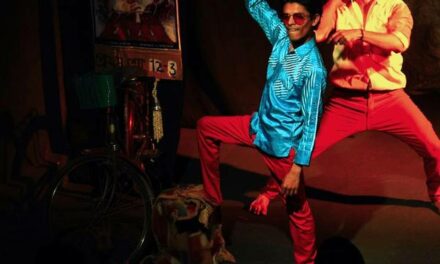What might Anton Chekov, that Russian master of the nineteenth century, have to say about the current climate crisis? A recent production of The Cherry Orchard by PETE (Portland Experimental Theatre Ensemble) poses this question by setting the action of the play in the melting Arctic of the near future. “The Cherry Orchard is about a family that loses their home during changing political times,” director Alice Reagan writes in her program note. “Our Cherry Orchard is about that, and also about a world that is slowly (then quickly, with the CRACK of an iceberg) disappearing, destroyed by us humans.” In a way, the theatrical canon itself can be seen as a form of sustainability, material that we recycle, again and again, reworking and revising to bring out fresh meaning with each new iteration. But while the classics provide fertile ground for exploration, can they be as effective at addressing the pressing concerns of the present as new writing? While aspects of Chekov’s The Cherry Orchard lend themselves to an ecocritical reading, it is the extratextual elements of PETE’s production that best communicate its aims, demonstrating both the possibilities within and the limitations to a reworking of the classics.
The text itself—in a new translation by Štepán Šimek that was adapted and directed by Reagan—remains quite faithful to its source material. Characters still refer to Paris and peasants, telegrams and railroads, and the core of the plot remains unchanged. An impoverished aristocrat, Lyubov Ranyevskaya (Amber Whitehall), and her daughter Anya (Sofía Marks) have returned to the family estate, which is set to be auctioned off unless they can pay the outstanding mortgage. They are reunited with Ranyevskaya’s brother Leo Gayev (Cristi Miles) and adopted daughter Varya (Rebecca Lingafelter), who have been left to manage the estate in her absence. Also awaiting her return is the self-made businessman Lopakhin (Jacob Coleman), who has gone from peasant to profiteer, and the perpetual student Trofimov (Murri Lazaroff-Babin), who was tutor to Ranyevskaya’s son before the boy’s tragic death.
And that is all. The most significant adaptation that Reagan makes is paring down the cast of characters to this lean six. Gone are the servants and hangers-on that comprise the extended entourage of the original. Instead, scenes are cut and lines reassigned, allowing the play to run at a crisp ninety minutes without intermission. This also allows the play to focus on the family and their relationship to their environment, with the central question of how to save the estate a convenient metaphor for global conservation. However, neither the dissipated ruling class nor the rising merchant Lopakhin offers a satisfactory answer. On the one hand, you have the neglectful stewards who have forgotten the old ways, though it is unclear whether these are the ways of preservation (“It only bears cherries every other year,” Lopakhin complains) or of extractive economics (“And the money!” Gayev rhapsodizes). On the other, you have the capitalist impulses that threaten the integrity of the estate itself: cutting down the orchard and leasing out lots for the building of vacation homes. And while Lopakhin paints an optimistic picture of summer vacationers—”it’s entirely possible that one day they’ll start cultivating their three acres, and then your cherry orchard will become a happy, bright, and magnificent place”—it sounds uncomfortably close to how we continue to look to the next generation to solve an escalating climate crisis of our own making.
The production’s palimpsestic approach is cleverly articulated in the play’s design, which layers the world of nineteenth-century Russia with a post-apocalyptic near-future. The set, designed by Peter Ksander, is a jewel box of a nursery with a parquet floor and sprawling green floral wallpaper. Yet the room also has hints of the bunker about it. The wallpaper ends to reveal exposed concrete, and an inset ledge at the top of the back wall is accessed by a metal ladder that descends from the theatre’s flies. This ladder also allows characters glimpses out of the window placed high above their heads recalling Samuel Beckett’s Endgame (another apocalyptic stage space). Wrapping around the nursery is an uninterrupted panorama of a frozen arctic sea, the high winds of which are evoked any time a player opens a door, the actors contorting their bodies as if pummeled by an icy blast as they shout above the roar.
Jenny Ampersand’s costume design is particularly adept at merging the iconography of the source material with the production’s ecocritical spin. Ranyevskaya’s engulfing white coat marries the sumptuousness of a Zhivago fur with the insulation of a quilted duvet, while Varya’s pragmatic attire flirts between Russian peasant and off-the-grid survivalist. The green and red of Russian military uniforms are transformed into racing-striped tracksuit pants for Lopakhin, and the comical figure of Gayev struts around the stage in white face powder (complete with faux beauty mark) and lace cravat and cuffs attached to a grey union suit (complete with buttoned back flap).
Like the visual elements of the show’s design, it is in the extratextual moments that PETE’s Cherry Orchard is most affecting, both as a performance and as contemporary commentary. For example, the cutting of characters necessitates the immediate breaking of the fourth wall and the Stanislavskian realism so often attached to Chekov’s work. With no Dunyasha on stage, a solitary Lopakhin must turn instead to the audience for help, literally calling for and responding to the time as he wakes up late to meet the train (“You could have told me,” he chastises us). Direct address is used throughout as characters confide their thoughts to the audience as much as each other, and audience interaction bookends the play with a heartbroken Varya asking the audience to sing Beyonce’s “Single Ladies” for her after Lopakhin’s non-proposal.
Reagan’s strategic cuts also create more spaces to explore the cherry orchard as the climate in crisis. When a chilling sound like a sonar ping interrupts an idyllic picnic in Act Two, Varya notes that “Before the disaster, it was just like that.” In Chekov’s original, the servant Firs identifies this disaster as the freeing of the serfs. However, in this version the question of which disaster is left hanging unanswered in the air, allowing the audience to project the many possible responses that our current headlines offer. This is swiftly followed by another intrusion—in the original, in the form of a drunken passerby who asks for directions and then money. Ranyevskaya, in characteristic fecklessness, gives him a large bill when she cannot find any change. In this adaptation, the figure of the passerby is kept offstage; instead, Trofimov warns, “Someone’s coming,” and the group reacts to the approach of the unseen stranger by transforming into a snarling, howling pack whose baying can only be quieted by Ranyevskaya ceremoniously emptying out the last coins in her purse like a quiet blood sacrifice.
This heightened moment echoes the interstitial transitions between acts, which the production maximizes by turning simple scene changes into extended passages of movement and sound. At the end of Act One, for example, Varya sings a mourning song, her headlamp illuminating the dimmed nursery as Lopakhin, Ranyevskaya, and Gayev invade the space cloaked in white parachutes that transform them into mutated ice monsters. The trio poses in a riveting tableau vivant before the sheets are whipped off to become simple picnic blankets for Act Two. At the end of Act Three, with the cherry orchard sold to a Lopakhin so aggressively triumphant that he licks the floor, Ranyesvskaya escapes the bounds of the nursery altogether, climbing down the wall of the set to the stage floor, processing slowly across, and sliding along the ground to disappear under the stage riser. Her singing transforms into the guttural keening of the arctic wind as the women of the play reenter the nursery howling with fury and despair, draped in the white cloths from the picnic which they slowly drape over the fallen furniture—part drop cloth, part snowdrift, as the boundary between interior and exterior begins to collapse.
At the close of the play, the characters have departed; they stand in a line on the stage floor in front of the now-abandoned nursery, their backs to the audience, calling to each other across the desolate expanse. The first chop of the ax becomes the cracking of an iceberg, and the lights fade to black. After the applause and the return of the house lights, we are invited to collect packets of seeds on our way out, to cultivate our own patch of land in a small gesture towards preservation. But one wonders, still haunted by the noise of disaster if this isn’t like Lopakhin’s summer people or the futile efforts of Ranyevskaya and Gayev—a little too little, too late.
The Cherry Orchard
PETE (Portland Experimental Theatre Ensemble)
Portland, Oregon, USA
June 24 – July 16, 2022
This post was written by the author in their personal capacity.The opinions expressed in this article are the author’s own and do not reflect the view of The Theatre Times, their staff or collaborators.
This post was written by Justine Nakase.
The views expressed here belong to the author and do not necessarily reflect our views and opinions.


















